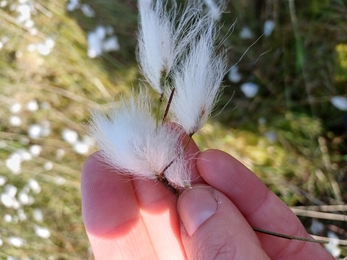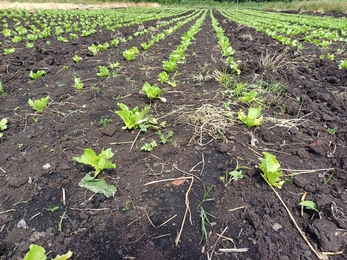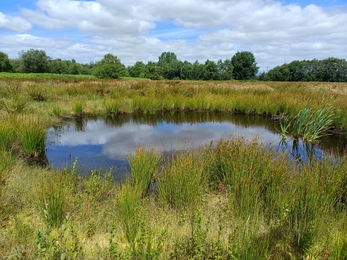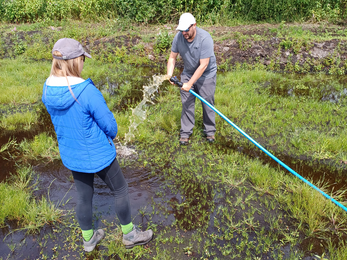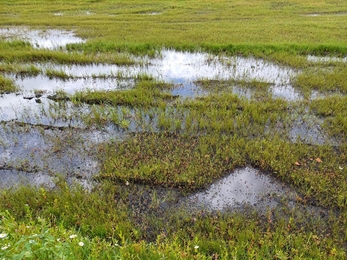There is no better way to learn and get inspired than to visit other people and take a deep dive into what they are doing and how it is working. That’s what we were lucky enough to be able to do recently on a trip to see the amazing peatland restoration and research that Lancashire Wildlife Trust are doing!
Wet feet and lifted spirits
A new wet farm near Manchester
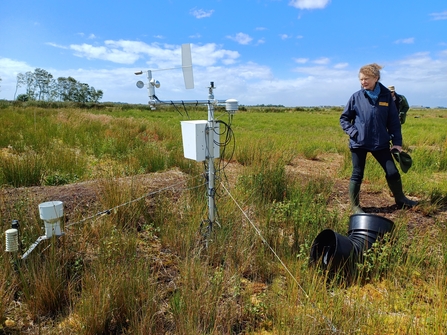
Equipment for monitoring water levels, weather and soil moisture so that perfect conditions can be maintained for the moss as it grows.
Reviving raised bogs
We started our visit with a blustery trip to Winmarleigh, a peaty SSSI site that is being brought back to life, surrounded by a moss farm and grazing pastures which are being converted back into wetlands. The staff are so knowledgeable and inspiring – filled with passion and an intimate connection to the landscape and how it works – we couldn’t help but feel uplifted.
They are working with farmers to reverse the drainage of the peat and hang on to rain water so that the habitat can heal itself. The whole area echoed with bird calls and was filled with the nodding fluffy heads of cotton grass.
Farming Carbon
Next to the beautiful nature reserve there sits a smallish area of wet farming – moss farming – where the crop is not the moss itself, but the carbon that it will lock in. Most of the moss here is not for harvest but here to stay – capturing carbon from the air as it grows and preserving it as plant material which gradually becomes peat.
The Winmarleigh carbon farm has an otherworld charm all of its own, and it promises hope for the future. Those tiny mosses will protect the nature reserve next door, the soil itself and offer the beginning of a potential solution to climate change. After only a few years since planting, this amazing farm is already home to special wetland species such as sundews and clouds of dragonflies.
As well as the success we could see as we stood there, Lancashire Wildlife Trust have been working with local universities to prove what you can't see - that the carbon is here to stay, and to understand all of the impacts and emissions from what they are doing.
We left full of hope, but not a little envious of the high rainfall which helps this system to thrive!
Foodie research
Food is essential for life and as amazing as moss is, it's not going to be replacing the fruit, veg and grains on our plates. Food security is as important a consideration as climate change to all of us and so it was great see that like our wet farming trials, Lancashire also includes some edibles.
In this case, working with local farmers at a different site, the Lancashire Wildlife Trust is growing market garden crops at a higher water table than usual. We visited a plot where there are blueberries, celery and lettuce growing in damper conditions as part of a system where rain water can be recycled between restored bog areas and lower level cultivated peat. There is lots to learn about the challenges and potential benefits of this way of farming, and even more to understand about how it might be scaled up to commercial levels. Early results suggest that celery growing in this way releases 40% less carbon, but that the growing season might be more restricted. Maybe we will see ‘low carbon’ vegetables in our kitchens in future which attract a premium price much as organic produce does today.
The wetland adjacent to the vegetables has an important role of its own – now well on the way to recovery it will soon become a donor site – a source of wetland plants will be used to heal other peat bogs in the area. A much bigger version of the bog in a box scheme – where local people have been nurturing wetland plants ready to help restore their local landcapes.
Hi-tech wet farming
The culmination of our visit was a trip to a new wetter farm, just being established near Manchester. Making the most of novel drone technology for seeding, and automatic pumps, Gore House Farm is now growing Typha (bulrush).
The first tiny seedlings are just germinating and they will grow to form a sea of green, topped with the classic brown cigar-shaped seedheads which are the target crop for this project. Those seedheads, like the ones from our wet farming trials, will become the natural filling for puffer jackets and hopefully go some way to replacing synthetic fabrics in our winter wear.
It is early days in establishing working examples of wet farming, but here, as at the Great Fen, they are demonstrating possibilities, and learning to overcome challenges. We want to help the farming industry to find ways to create amazing produce and act as custodians for the carbon locked into peat soils, that way it stays in the ground providing us with crops rather than transforming into greenhouse gases and being lost forever.
The work that Lancashire Wildlife Trust shared with us gives hope for the future, that damage can sometimes be healed in just a handful of years and amazing things can be achieved with the right resources and enough rain. We can share our learning, and together the Wildlife Trusts are making a huge difference.


